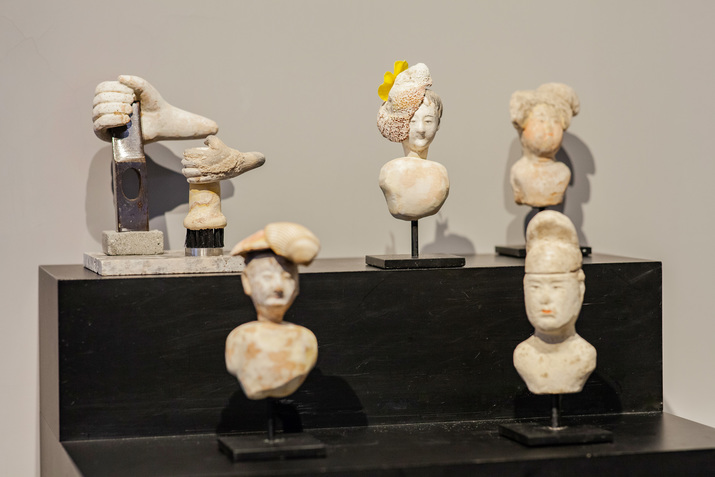-
From Current Issue
-
- Editor’s Letter Fire in the Heart
- Reviews I Gusti Ayu Kadek Murniasih
- Reviews 11th Seoul Mediacity Biennale: “One Escape at a Time”
- Dispatch Networked China
- One on One Monira Al Qadiri on Yukio Mishima
- Essays The rise of independent art spaces in pandemic-era Shanghai
- Features Tuan Andrew Nguyen
- Table of Contents
- Web Exclusives
- Archive
- Subscribe

R
E
V N
E
X
T
Installation view of (on the wall) LAM TUNG PANG’s Tealegram #1, 2020, acrylic and charcoal on plywood, 100 × 100 cm; and (on the table to the right) LAU HOK SHING’s Revisiting Qi Quan Zhai: A Tale of Isolation series, 2020, multimedia installation, dimensions variable, at “Up Close – Hollywood Road,” Gallery149, Hong Kong, 2020. All images courtesy the organizer of “Up Close – Hollywood Road.”
Hollywood Road is the second-oldest street on Hong Kong Island, built in 1844, shortly after the territory’s cession to the British crown. The street has been a hub for the antiques trade for nearly as long, although skyrocketing rent prices in recent years have forced many businesses to shutter. Curators Hilda Chan and Iven Cheung began discussing ideas for a project that would bridge this trade and contemporary art two years ago with local artist Leelee Chan, whose parents ran an antique shop in the area. “Up Close – Hollywood Road” is the fruit of their efforts, bringing new works by five Hong Kong artists to four spaces clustered on the city’s historic “antique street.”
The curators handpicked several of the artists for their connection to antiques or classical art and invited them to create pieces that resonated with the individual shops, lending natural coherence to the presentation. Leelee Chan’s Present Relics (2020) series, for instance, draws on the artist’s expertise as a collector and restorer of Northern Wei and Tang dynasty pottery figures. The miniature sculptural assemblages could easily be missed among the funerary statues at Bonnie Lai Antiquities if not for their subtle material and aesthetic incongruities, such as the seashells that serve as genteel hats for Chan’s fragmented figurines. Likewise, Bing Lee’s Museum of Obscure Objects (2020) blended in with the cluttered cabinets of Ming and Qing dynasty curios at Wing Hing Co. The artist’s invented artifacts veer between vaguely realistic, as with a replica of an opium pipe, and totally bizarre, such as a glass jar with spiky protrusions (the shop owner discerned that it is based on an opium lamp). Both of these projects probe the constructed nature of an art object’s value. A “fake” artifact by an artist carries significantly more worth in a contemporary art setting than in an antique shop; the dissociation between these dematerialized valuations came to the fore as the two contexts dissolved into one.
A harmonious dialogue arose between Lam Tung Pang’s plywood paintings, which borrow from the visual language of traditional shanshui, and Lau Hok Shing’s wooden sculptures, inspired by scholar’s rocks and other literati objects in his personal collection. On the ground floor of Gallery149, Lam’s painting of a young man moving a tiny mountain with a shovel hung on the wall behind Lau’s craggy form balanced on an orb. Upstairs, in the gallery’s exquisite room of teaware, Lau’s pair of sculptures evoking classical Chinese renderings of wispy clouds and mist echo the two teal patches floating in Lam’s Tealegram #1 (2020), depicting a picnic involving oversized teapots. Beyond visual parallels, the works reveal the artists’ concordant interests in playing with elements of landscape as a means of expressing collective anxieties in Hong Kong. Lam’s ground-floor work, Faith Moves Collections (2020), nods to the labor of curators, but the motif of giants manipulating scaled-down landscapes appears in Lam’s earlier works as an allusion to the competing social and political forces shaping the city. Meanwhile, Lau’s precarious composition, in which the wood is transformed to resemble a hill-shaped rock, leverages balance and illusion to evoke the instability born of the pandemic and Hong Kong’s free fall into authoritarianism.
The odd one out was Oscar Chan Yik Long’s Octopoda (2020), the only video in the exhibition and a departure from the artist’s well-known ink paintings of monstrous beings. Shown on an outmoded TV set, Octopoda reels through photographs of toys and other miscellanea in Chan’s home while a narrator humorously reflects on his personal relationships and struggles with anxiety in a distorted voiceover. The still images are animated by superimposed doodles that imbue objects with eyes and conjure demons in messy corners of the artist’s abode, conflating internal and external disarray. Despite its marked formal difference vis-à-vis the other artworks and surrounding antiques, Octopoda gestured at the intense subjectivity with which we project meaning onto objects, coalescing with other works’ explorations of what we mean when we say that an item has history.
Ophelia Lai is ArtAsiaPacific’s associate editor.
“Up Close – Hollywood Road” is open by appointment at multiple locations until July 18, 2020.
To read more of ArtAsiaPacific’s articles, visit our Digital Library.


















